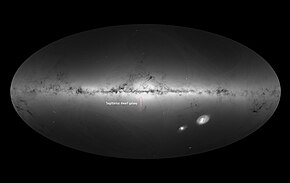| Sagittarius Dwarf Spheroidal Galaxy[1] | |
|---|---|
 The Sagittarius Dwarf Spheroidal Galaxy in Aitoff allsky view | |
| Observation data (J2000 epoch) | |
| Constellation | Sagittarius |
| Right ascension | 18h 55m 19.5s[2] |
| Declination | −30° 32′ 43″[2] |
| Redshift | 140 ± ? km/s[2] |
| Distance | 65 ± 7 kly (20 ± 2 kpc)[3][4] |
| Apparent magnitude (V) | 4.5[2] |
| Characteristics | |
| Type | dSph(t)[2] |
| Mass | 4×108[5] M☉ |
| Apparent size (V) | 450.0′ × 216.0′[2] |
| Notable features | Heading for a collision with the Milky Way |
| Other designations | |
| Sag DEG,[6] Sgr dSph,[2] Sagittarius Dwarf Spheroidal,[2] Sgr I Dwarf,[2] PGC 4689212[7] | |
The Sagittarius Dwarf Spheroidal Galaxy (Sgr dSph), also known as the Sagittarius Dwarf Elliptical Galaxy (Sgr dE or Sag DEG), is an elliptical loop-shaped satellite galaxy of the Milky Way. It contains four globular clusters in its main body,[8] with the brightest of them—NGC 6715 (M54)—being known well before the discovery of the galaxy itself in 1994. Sgr dSph is roughly 10,000 light-years in diameter, and is currently about 70,000 light-years from Earth, travelling in a polar orbit (an orbit passing over the Milky Way's galactic poles) at a distance of about 50,000 light-years from the core of the Milky Way (about one third of the distance of the Large Magellanic Cloud). In its looping, spiraling path, it has passed through the plane of the Milky Way several times in the past.[9] In 2018 the Gaia project of the European Space Agency showed that Sgr dSph had caused perturbations in a set of stars near the Milky Way's core, causing unexpected rippling movements of the stars triggered when it moved through the Milky Way between 300 and 900 million years ago.[10]
- ^ "Name SDG". SIMBAD. Centre de données astronomiques de Strasbourg. Retrieved 28 November 2006.
- ^ a b c d e f g h i "Saggitarius Dwarf Spheroidal". NASA/IPAC Extragalactic Database. Retrieved 28 November 2006.
- ^ Karachentsev, I. D.; Karachentseva, V. E.; Hutchmeier, W. K.; Makarov, D. I. (2004). "A Catalog of Neighboring Galaxies". The Astronomical Journal. 127 (4): 2031–2068. Bibcode:2004AJ....127.2031K. doi:10.1086/382905.
- ^ Karachentsev, I. D.; Kashibadze, O. G. (2006). "Masses of the local group and of the M81 group estimated from distortions in the local velocity field". Astrophysics. 49 (1): 3–18. Bibcode:2006Ap.....49....3K. doi:10.1007/s10511-006-0002-6. S2CID 120973010.
- ^ Cite error: The named reference
Verbetsky2020was invoked but never defined (see the help page). - ^ Sagittarius Dwarf Elliptical Galaxy / Sag DEG
- ^ eSky:Sagittarius Dwarf Galaxy
- ^ Cite error: The named reference
Minnitiwas invoked but never defined (see the help page). - ^ "Star-Crossed: Milky Way's spiral shape may result from a smaller galaxy's impact". Scientific American. 15 December 2016. Archived from the original on 15 December 2016.
- ^ Antoja, T.; Helmi, A.; Romero-Gómez, M.; Katz, D.; Babusiaux, C.; Drimmel, R.; Evans, D. W.; Figueras, F.; Poggio, E.; Reylé, C.; Robin, A. C.; Seabroke, G.; Soubiran, C. (19 September 2018). "A dynamically young and perturbed Milky Way disk". Nature. 561 (7723): 360–362. arXiv:1804.10196. Bibcode:2018Natur.561..360A. doi:10.1038/s41586-018-0510-7. PMID 30232428. S2CID 52298687.